2023年仁爱版中考英语语法复习课件句子种类(共44张PPT)
文档属性
| 名称 | 2023年仁爱版中考英语语法复习课件句子种类(共44张PPT) |  | |
| 格式 | pptx | ||
| 文件大小 | 574.8KB | ||
| 资源类型 | 教案 | ||
| 版本资源 | 仁爱科普版 | ||
| 科目 | 英语 | ||
| 更新时间 | 2023-08-08 08:00:59 | ||
图片预览

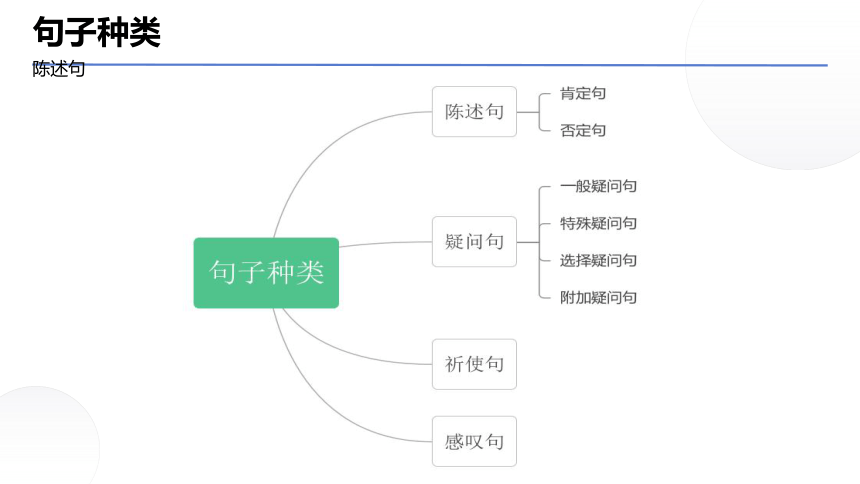
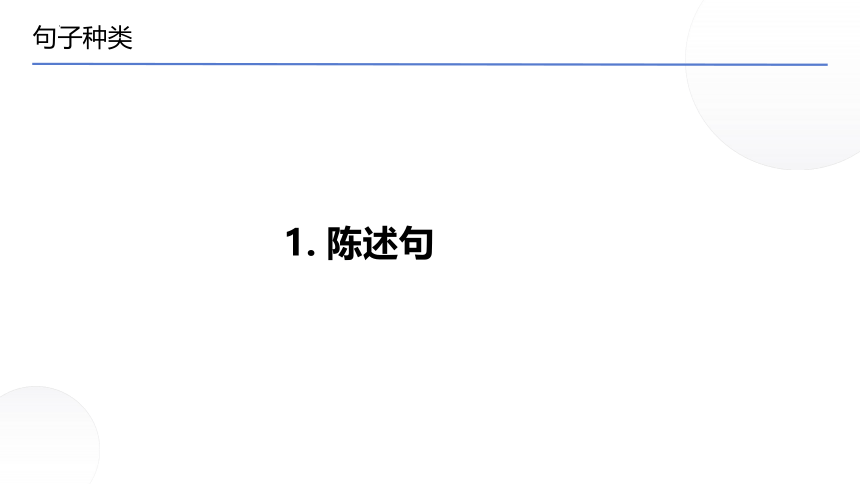
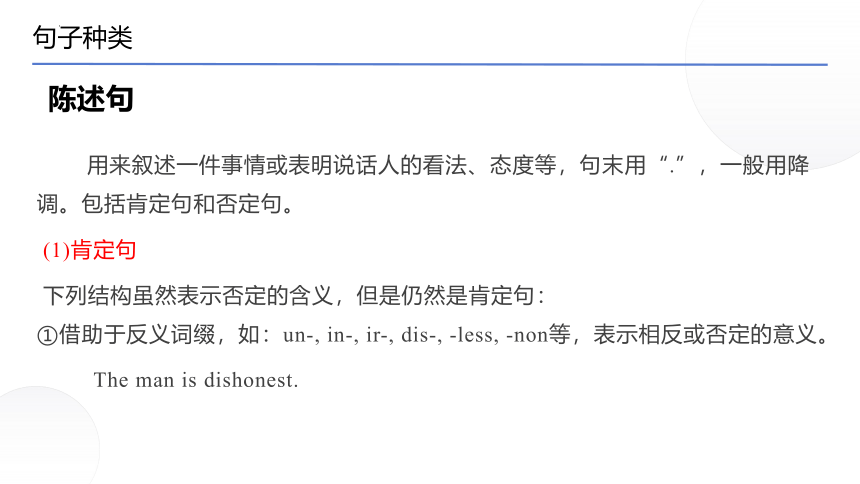
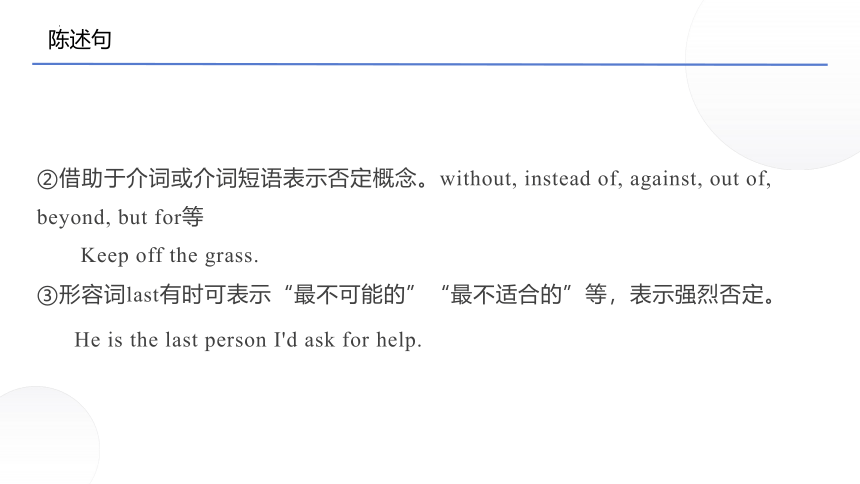
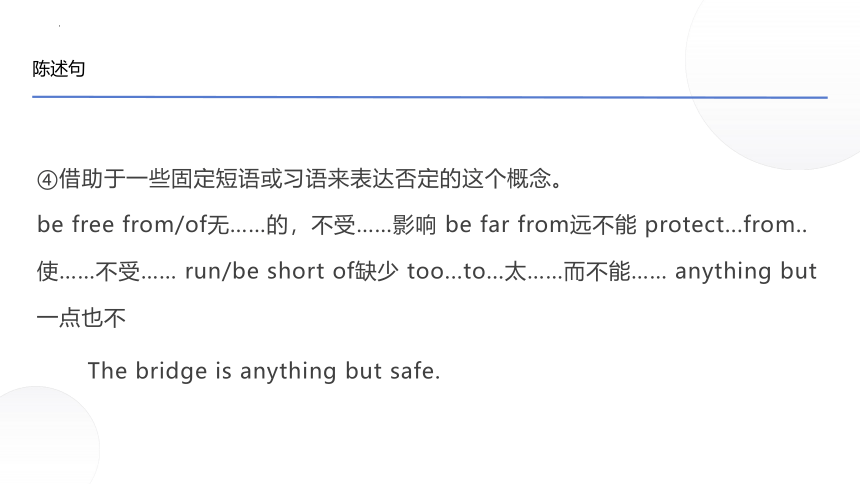
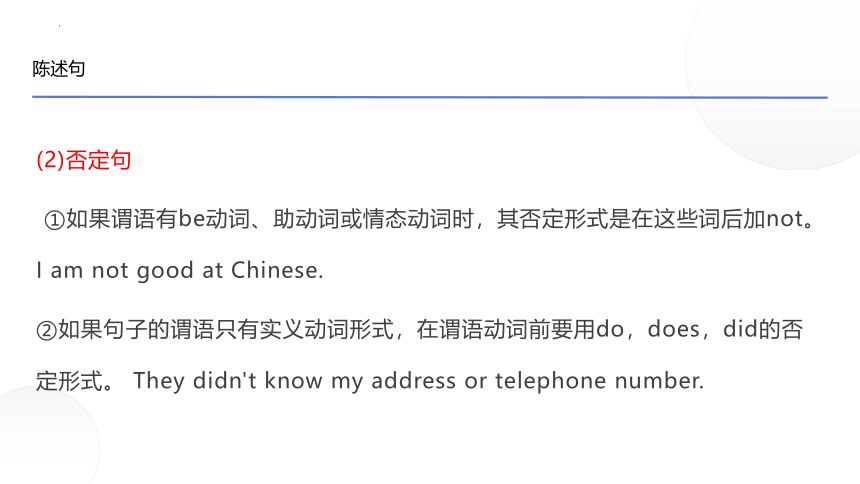
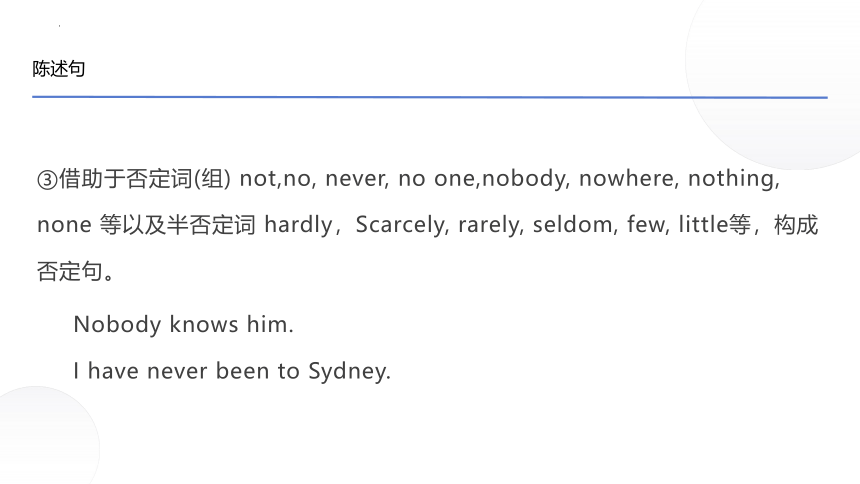
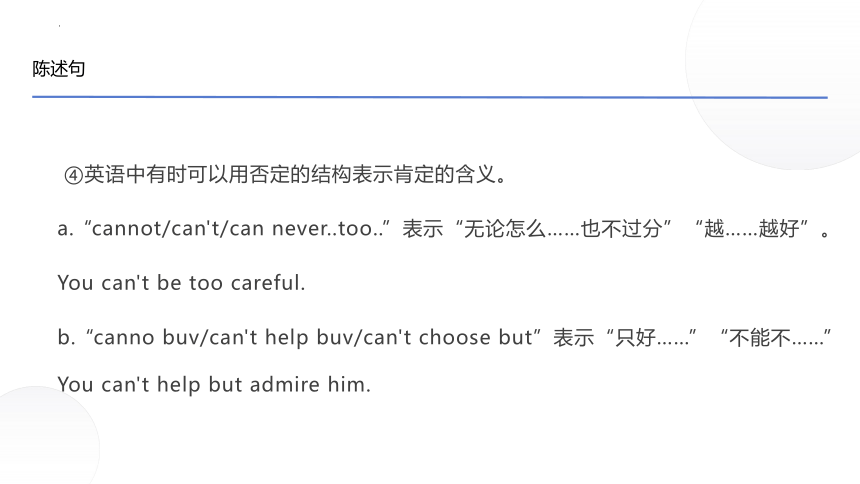
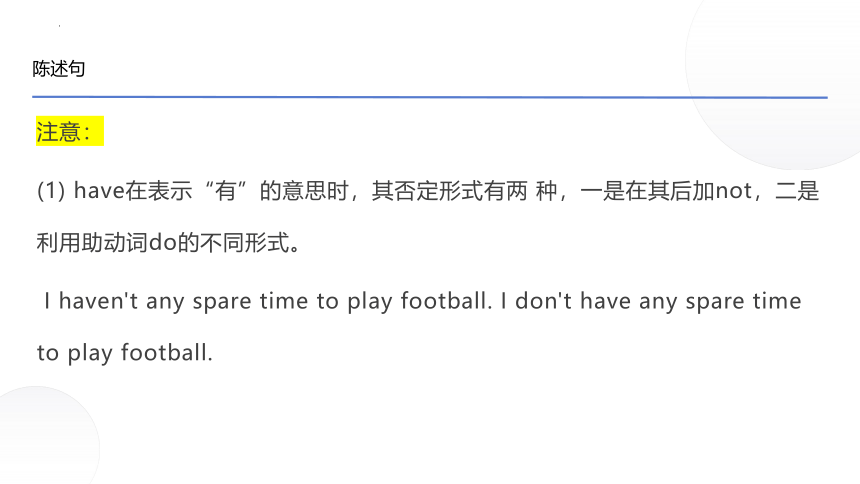
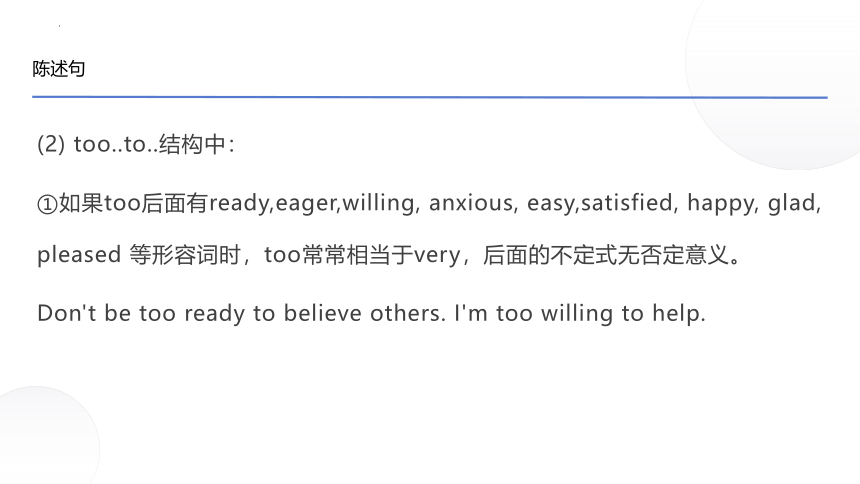
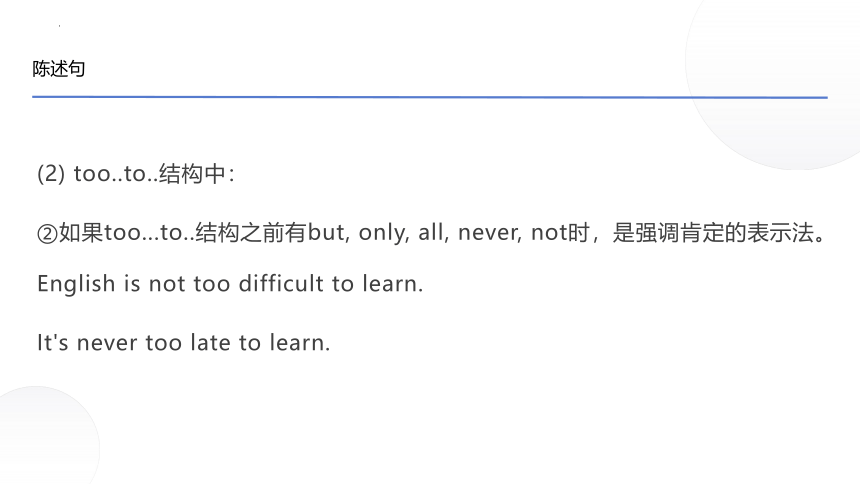
文档简介
(共44张PPT)
一、句子成分和句子种类
句子种类
陈述句
句子种类
1. 陈述句
句子种类
陈述句
用来叙述一件事情或表明说话人的看法、态度等,句末用“.”,一般用降调。包括肯定句和否定句。
(1)肯定句
下列结构虽然表示否定的含义,但是仍然是肯定句:
①借助于反义词缀,如:un-, in-, ir-, dis-, -less, -non等,表示相反或否定的意义。
The man is dishonest.
陈述句
②借助于介词或介词短语表示否定概念。without, instead of, against, out of, beyond, but for等
Keep off the grass.
③形容词last有时可表示“最不可能的”“最不适合的”等,表示强烈否定。
He is the last person I'd ask for help.
陈述句
④借助于一些固定短语或习语来表达否定的这个概念。
be free from/of无……的,不受……影响 be far from远不能 protect...from..使……不受…… run/be short of缺少 too...to...太……而不能…… anything but一点也不
The bridge is anything but safe.
陈述句
(2)否定句
①如果谓语有be动词、助动词或情态动词时,其否定形式是在这些词后加not。 I am not good at Chinese.
②如果句子的谓语只有实义动词形式,在谓语动词前要用do,does,did的否定形式。 They didn't know my address or telephone number.
陈述句
③借助于否定词(组) not,no, never, no one,nobody, nowhere, nothing, none 等以及半否定词 hardly,Scarcely, rarely, seldom, few, little等,构成否定句。
Nobody knows him.
I have never been to Sydney.
陈述句
④英语中有时可以用否定的结构表示肯定的含义。
a.“cannot/can't/can never..too..”表示“无论怎么……也不过分”“越……越好”。
You can't be too careful.
b.“canno buv/can't help buv/can't choose but”表示“只好……”“不能不……” You can't help but admire him.
陈述句
注意:
(1) have在表示“有”的意思时,其否定形式有两 种,一是在其后加not,二是利用助动词do的不同形式。
I haven't any spare time to play football. I don't have any spare time to play football.
陈述句
(2) too..to..结构中:
①如果too后面有ready,eager,willing, anxious, easy,satisfied, happy, glad,
pleased 等形容词时,too常常相当于very,后面的不定式无否定意义。
Don't be too ready to believe others. I'm too willing to help.
陈述句
(2) too..to..结构中:
②如果too...to..结构之前有but, only, all, never, not时,是强调肯定的表示法。 English is not too difficult to learn.
It's never too late to learn.
陈述句
③在“too..to…”结构中,不定式为否定式时,构成双重否定,译成“非常/很……,不会不……”
He is too kind not to help you.
句子种类
2. 疑问句
疑问句
(1)一般疑问句
用yes,no来回答的疑问句叫做一般疑问句,但在口语中有时也用yes,no之外的词或词组回答。口语中若无特殊含义,句末用升调。
一般疑问句
用法:
①用yes,no回答的一般疑问句
Are your parents doctors
Yes,they both are.
一般疑问句
②用yes,no之外的词回答的一般疑问句 一般疑问句也可用其他表示肯定或否定的词或词组回答,如certainly, surely, of course, I think so,all right ,certainly not, not at all, never, sorry, not yet, afraid not等。
Would you mind my joining your talk
Of course not.
一般疑问句
构成:
① 若句子的谓语包含助动词、情态动词或系动词be时,则只需把它们提到主语的前面去就可构成疑问句形式;
若句子谓语不包含助动词、情态动词或系动词be,则需借助于助动词do/does/did才能构成疑问句,句子原来的谓语动词则要用原形。
Were they happy at the news Do you always tell your daughter a story at home
一般疑问句
②及物动词have表示“有”的含义时,可以把它提到主语的前面,也可以借助于助动词do构成疑问结构;当have表示其他含义时,则只能借助于助动词构成疑问结构。
Have you any brothers Do you have any brothers
特殊疑问句
特殊疑问句是由特殊疑问代词what, who, whom, which, whose或特殊疑问副词when, where, why, how等引导的疑问句,不用yes或no回答。
(2)特殊疑问句
特殊疑问句的基本结构
特殊疑问词 +be 动词 + 主语 + 其它 +?
特殊疑问词 +情态动词 + 主语 + 其它 +?
特殊疑问词 + 助动词 + 主语 + 动词 + 其它 +?
特殊疑问句=特殊疑问词 +一般疑问句语序
问什么答什么
特殊疑问词用法 疑问词 意思 用法 例句
who 谁 询问人的身份、姓名等 Who is that ---That is Tim.
whose 谁的 问所属关系 Whose bag it is ---It is mine.
what 什么 问人的职业和事物是什么 What’s this in English
---This is a map.
What’s your father
---He is a doctor.
what time 几点 问时间点 Whattime is it now ---It is 9 o’clock.
特殊疑问词用法 疑问词 意思 用法 例句
what day 星期几 问日期 What day is it ---Monday.
what date 几月几日 What date is it ---It is July 12th.
what color 什么颜色 问颜色 Whatcolor is your bag ---It is pink.
where 在哪里 问地点 Where are you from ---I am from America.
how 怎样 问健康状况、做事的方式等 Howare you ---I’m fine, thanks.
How do you spell it ---E-R-A-S-E-R, eraser.
特殊疑问词用法 疑问词 意思 用法 例句
how old 多大(多少岁) 询问年龄 How old are you ---I’m twelve.
how much 多少 询问数量(不可数名词) How much water do we need ---Three bottles.
howmany 多少 询问数量(可数名词) How many birds are in the tree ---Nine.
how soon 多久之后 对in+一段时间提问 How soon will you come back ---In two weeks.
how far 多远 对距离提问 How far is it from your home to school
---About 5 kilometers.
说话者对问题提出两个或两个以上的答案,供对定义方选择其一。前部分用升调,后部分用降调。
(3)选择疑问句
选择疑问句
有两种形式:
一种是以一般疑问句为基础,另一种形式是以特殊疑问句为基础。or 连接的并列成分可以是状语、宾语、表语、谓语或两个句子
Shall we go home or stay here for the night
Are you British or French
Shall I do it or will you do it yourself
附加疑问句由两部分构成,一部分是陈述句,另一构成一部分是附加在陈述句后面的一种简短的问句,又叫疑问尾句。
(4)附加疑问句
特征:
简短问句与陈述句之间用逗号隔开,且它的主语总是特征使用代词,这个代词与前面陈述句中的主语要保持一致。一般情况下,肯定的陈述句后跟否定的简短问句,否定的陈述句后跟肯定的简短问句
You dislike sports, don't you
Sophia is not good at playing the violin,is she
附加疑问句
在回答这类问句时,不管简短问句前的陈述句是回答 肯定的还是否定的,肯定的回答要用yes,否定回方式答要用no。可以简单地列出这样一个公式:
陈述句+简短问句:“肯定,+否定”或“否定,+肯定”答句的两部分:“肯定,+肯定”或“否定,+否定”
You attended the conference, didn't you
Yes,I did./No,I didn't.
You didn't attend the conference,did you
No,I didn't./Yes,I did.
附加疑问句
句子种类
3. 祈使句
祈使句
表示请求或命令的句子是祈使句。祈使句的谓语动词一般用动词原形。口语中读时常用降调,句末用句号或感叹号。
祈使句
用法
(1)祈使句的主语通常是第二人称(you),一般不需要说出,但有时为了强调主语或指明向谁提出请求或发出命令,可以加上主语或其他称呼语。这时主语须重读。
You be quiet for a moment.
Jack,close the window!
祈使句
表示强调的另一方法是在谓语动词前面加 do
Do be careful next time.
Do listen to your teachers!千万
祈使句
(2)祈使句的否定式是在肯定式的谓语动词前加don't或never
Don't ever do that again.
Never lie to others.
祈使句
(3)以let开头的祈使句,肯定式用“Let+宾语+动词原形”,否定式用“Let+宾语+not+动词原形”,也可用“Don't let+宾语+动词原形”的形式。
Let's read this dialogue.
Don't let anyone disturb you.
Let's not have a rest.
祈使句
(4)不包含动词的祈使句
Quick!快!
No parking! 不准停车!
No smoking! 禁止吸烟!
Off with your shoes. 把你的鞋子脱掉。
Eyes front! 向前看!(口令)
祈使句
(5)祈使句+and+陈述句 = If...+主句;祈使句+or+ 陈述句= If... not.... +主句
Work hard and you will succeed. (=If you work hard, you will succeed.)
Hurry up or we will be late.(=If you don't hurry up, we will be late.)
Please give me a hand.请帮我
祈使句
(6)为了使祈使句听起来比较客气、婉转,除了用低声调外,还可加please或will you。
Lend me your dictionary,please.
Read the text,will you
句子种类
4. 感叹句
句子种类
感叹句
感叹句是表示喜、怒、哀、乐等情感的句子。一般用how或what开头,how作状语,修饰形容词、副词或句子;what作定语,修饰名词(名词前可有形容词或冠词)。感叹句要用降调,句末用感叹号。
句子种类
感叹句
(1)基本构成形式
What (+ a/an)+形容词+名词+主语+谓语!
How +形容词+a/an+单数可数名词+主语+谓语!
How+形容词/副词+主语+谓语!
What a clever boy he is!
=How clever a boy he is!
=How clever the boy is!
句子种类
感叹句
(2)省略形式的感叹句
how直接修饰:How+主语+ 谓语+宾语!
How (much) we love our motherland!
省略主语和谓语
What an interesting book( it is)!
句子种类
感叹句
(3)其他形式的感叹句
由一个词、一个词组或一个其他类型的句子转变过来
How can you be so silly!
Wonderful!
谢谢
一、句子成分和句子种类
句子种类
陈述句
句子种类
1. 陈述句
句子种类
陈述句
用来叙述一件事情或表明说话人的看法、态度等,句末用“.”,一般用降调。包括肯定句和否定句。
(1)肯定句
下列结构虽然表示否定的含义,但是仍然是肯定句:
①借助于反义词缀,如:un-, in-, ir-, dis-, -less, -non等,表示相反或否定的意义。
The man is dishonest.
陈述句
②借助于介词或介词短语表示否定概念。without, instead of, against, out of, beyond, but for等
Keep off the grass.
③形容词last有时可表示“最不可能的”“最不适合的”等,表示强烈否定。
He is the last person I'd ask for help.
陈述句
④借助于一些固定短语或习语来表达否定的这个概念。
be free from/of无……的,不受……影响 be far from远不能 protect...from..使……不受…… run/be short of缺少 too...to...太……而不能…… anything but一点也不
The bridge is anything but safe.
陈述句
(2)否定句
①如果谓语有be动词、助动词或情态动词时,其否定形式是在这些词后加not。 I am not good at Chinese.
②如果句子的谓语只有实义动词形式,在谓语动词前要用do,does,did的否定形式。 They didn't know my address or telephone number.
陈述句
③借助于否定词(组) not,no, never, no one,nobody, nowhere, nothing, none 等以及半否定词 hardly,Scarcely, rarely, seldom, few, little等,构成否定句。
Nobody knows him.
I have never been to Sydney.
陈述句
④英语中有时可以用否定的结构表示肯定的含义。
a.“cannot/can't/can never..too..”表示“无论怎么……也不过分”“越……越好”。
You can't be too careful.
b.“canno buv/can't help buv/can't choose but”表示“只好……”“不能不……” You can't help but admire him.
陈述句
注意:
(1) have在表示“有”的意思时,其否定形式有两 种,一是在其后加not,二是利用助动词do的不同形式。
I haven't any spare time to play football. I don't have any spare time to play football.
陈述句
(2) too..to..结构中:
①如果too后面有ready,eager,willing, anxious, easy,satisfied, happy, glad,
pleased 等形容词时,too常常相当于very,后面的不定式无否定意义。
Don't be too ready to believe others. I'm too willing to help.
陈述句
(2) too..to..结构中:
②如果too...to..结构之前有but, only, all, never, not时,是强调肯定的表示法。 English is not too difficult to learn.
It's never too late to learn.
陈述句
③在“too..to…”结构中,不定式为否定式时,构成双重否定,译成“非常/很……,不会不……”
He is too kind not to help you.
句子种类
2. 疑问句
疑问句
(1)一般疑问句
用yes,no来回答的疑问句叫做一般疑问句,但在口语中有时也用yes,no之外的词或词组回答。口语中若无特殊含义,句末用升调。
一般疑问句
用法:
①用yes,no回答的一般疑问句
Are your parents doctors
Yes,they both are.
一般疑问句
②用yes,no之外的词回答的一般疑问句 一般疑问句也可用其他表示肯定或否定的词或词组回答,如certainly, surely, of course, I think so,all right ,certainly not, not at all, never, sorry, not yet, afraid not等。
Would you mind my joining your talk
Of course not.
一般疑问句
构成:
① 若句子的谓语包含助动词、情态动词或系动词be时,则只需把它们提到主语的前面去就可构成疑问句形式;
若句子谓语不包含助动词、情态动词或系动词be,则需借助于助动词do/does/did才能构成疑问句,句子原来的谓语动词则要用原形。
Were they happy at the news Do you always tell your daughter a story at home
一般疑问句
②及物动词have表示“有”的含义时,可以把它提到主语的前面,也可以借助于助动词do构成疑问结构;当have表示其他含义时,则只能借助于助动词构成疑问结构。
Have you any brothers Do you have any brothers
特殊疑问句
特殊疑问句是由特殊疑问代词what, who, whom, which, whose或特殊疑问副词when, where, why, how等引导的疑问句,不用yes或no回答。
(2)特殊疑问句
特殊疑问句的基本结构
特殊疑问词 +be 动词 + 主语 + 其它 +?
特殊疑问词 +情态动词 + 主语 + 其它 +?
特殊疑问词 + 助动词 + 主语 + 动词 + 其它 +?
特殊疑问句=特殊疑问词 +一般疑问句语序
问什么答什么
特殊疑问词用法 疑问词 意思 用法 例句
who 谁 询问人的身份、姓名等 Who is that ---That is Tim.
whose 谁的 问所属关系 Whose bag it is ---It is mine.
what 什么 问人的职业和事物是什么 What’s this in English
---This is a map.
What’s your father
---He is a doctor.
what time 几点 问时间点 Whattime is it now ---It is 9 o’clock.
特殊疑问词用法 疑问词 意思 用法 例句
what day 星期几 问日期 What day is it ---Monday.
what date 几月几日 What date is it ---It is July 12th.
what color 什么颜色 问颜色 Whatcolor is your bag ---It is pink.
where 在哪里 问地点 Where are you from ---I am from America.
how 怎样 问健康状况、做事的方式等 Howare you ---I’m fine, thanks.
How do you spell it ---E-R-A-S-E-R, eraser.
特殊疑问词用法 疑问词 意思 用法 例句
how old 多大(多少岁) 询问年龄 How old are you ---I’m twelve.
how much 多少 询问数量(不可数名词) How much water do we need ---Three bottles.
howmany 多少 询问数量(可数名词) How many birds are in the tree ---Nine.
how soon 多久之后 对in+一段时间提问 How soon will you come back ---In two weeks.
how far 多远 对距离提问 How far is it from your home to school
---About 5 kilometers.
说话者对问题提出两个或两个以上的答案,供对定义方选择其一。前部分用升调,后部分用降调。
(3)选择疑问句
选择疑问句
有两种形式:
一种是以一般疑问句为基础,另一种形式是以特殊疑问句为基础。or 连接的并列成分可以是状语、宾语、表语、谓语或两个句子
Shall we go home or stay here for the night
Are you British or French
Shall I do it or will you do it yourself
附加疑问句由两部分构成,一部分是陈述句,另一构成一部分是附加在陈述句后面的一种简短的问句,又叫疑问尾句。
(4)附加疑问句
特征:
简短问句与陈述句之间用逗号隔开,且它的主语总是特征使用代词,这个代词与前面陈述句中的主语要保持一致。一般情况下,肯定的陈述句后跟否定的简短问句,否定的陈述句后跟肯定的简短问句
You dislike sports, don't you
Sophia is not good at playing the violin,is she
附加疑问句
在回答这类问句时,不管简短问句前的陈述句是回答 肯定的还是否定的,肯定的回答要用yes,否定回方式答要用no。可以简单地列出这样一个公式:
陈述句+简短问句:“肯定,+否定”或“否定,+肯定”答句的两部分:“肯定,+肯定”或“否定,+否定”
You attended the conference, didn't you
Yes,I did./No,I didn't.
You didn't attend the conference,did you
No,I didn't./Yes,I did.
附加疑问句
句子种类
3. 祈使句
祈使句
表示请求或命令的句子是祈使句。祈使句的谓语动词一般用动词原形。口语中读时常用降调,句末用句号或感叹号。
祈使句
用法
(1)祈使句的主语通常是第二人称(you),一般不需要说出,但有时为了强调主语或指明向谁提出请求或发出命令,可以加上主语或其他称呼语。这时主语须重读。
You be quiet for a moment.
Jack,close the window!
祈使句
表示强调的另一方法是在谓语动词前面加 do
Do be careful next time.
Do listen to your teachers!千万
祈使句
(2)祈使句的否定式是在肯定式的谓语动词前加don't或never
Don't ever do that again.
Never lie to others.
祈使句
(3)以let开头的祈使句,肯定式用“Let+宾语+动词原形”,否定式用“Let+宾语+not+动词原形”,也可用“Don't let+宾语+动词原形”的形式。
Let's read this dialogue.
Don't let anyone disturb you.
Let's not have a rest.
祈使句
(4)不包含动词的祈使句
Quick!快!
No parking! 不准停车!
No smoking! 禁止吸烟!
Off with your shoes. 把你的鞋子脱掉。
Eyes front! 向前看!(口令)
祈使句
(5)祈使句+and+陈述句 = If...+主句;祈使句+or+ 陈述句= If... not.... +主句
Work hard and you will succeed. (=If you work hard, you will succeed.)
Hurry up or we will be late.(=If you don't hurry up, we will be late.)
Please give me a hand.请帮我
祈使句
(6)为了使祈使句听起来比较客气、婉转,除了用低声调外,还可加please或will you。
Lend me your dictionary,please.
Read the text,will you
句子种类
4. 感叹句
句子种类
感叹句
感叹句是表示喜、怒、哀、乐等情感的句子。一般用how或what开头,how作状语,修饰形容词、副词或句子;what作定语,修饰名词(名词前可有形容词或冠词)。感叹句要用降调,句末用感叹号。
句子种类
感叹句
(1)基本构成形式
What (+ a/an)+形容词+名词+主语+谓语!
How +形容词+a/an+单数可数名词+主语+谓语!
How+形容词/副词+主语+谓语!
What a clever boy he is!
=How clever a boy he is!
=How clever the boy is!
句子种类
感叹句
(2)省略形式的感叹句
how直接修饰:How+主语+ 谓语+宾语!
How (much) we love our motherland!
省略主语和谓语
What an interesting book( it is)!
句子种类
感叹句
(3)其他形式的感叹句
由一个词、一个词组或一个其他类型的句子转变过来
How can you be so silly!
Wonderful!
谢谢
同课章节目录
- 词法
- 名词
- 动词和动词短语
- 动词语态
- 动词时态
- 助动词和情态动词
- 非谓语动词
- 冠词
- 代词
- 数词和量词
- 形容词副词及其比较等级
- 介词和介词短语
- 连词和感叹词
- 构词法
- 相似、相近词比较
- 句法
- 陈述句
- 一般疑问句和否定疑问句
- 特殊疑问句及选择疑问句
- 反意疑问句
- 存在句(There be句型)
- 宾语从句
- 定语从句
- 状语从句
- 主谓一致问题
- 简单句
- 并列句
- 复合句
- 主谓一致
- 主、表语从句
- 名词性从句
- 直接引语和间接引语
- 虚拟语气
- 感叹句
- 强调句
- 倒装句
- 祈使句
- 句子的成分
- 句子的分类
- 题型专区
- 单项选择部分
- 易错题
- 完形填空
- 阅读理解
- 词汇练习
- 听说训练
- 句型转换
- 补全对话
- 短文改错
- 翻译
- 书面表达
- 任务型阅读
- 语法填空
- 其他资料
